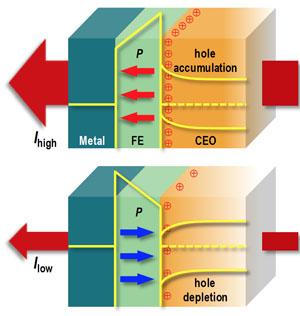
FE control of electronic transport is one of the emerging technologies in oxide heterostructures. Many previous efforts in FTJs exploited solely the differences in the electrostatic potential across the FTJs induced by changes in the FE polarization direction. However, this work shows that in practice the junction current ratio between the two polarization states is largely influenced by the electrostatic modification in the correlated electron oxide electrodes. Therefore, our discovery of the enhanced TER effect by interfacial phase transitions ultimately highlights that the strong coupling between degrees of freedom across heterointerfaces could yield versatile and novel applications in oxide electronics.
L. Jiang, W. S. Choi, H. Jeen, S. Dong, Y. Kim, M.-G. Han, Y. Zhu, S. V. Kalinin, E. Dagotto, T. Egami, and H. N. Lee, “Tunneling Electroresistance Induced by Interfacial Phase Transitions in Ultrathin Oxide Heterostructures,” Nano Lett. 13, 5837 (2013). DOI: 10.1021/nl4025598
For more information:

